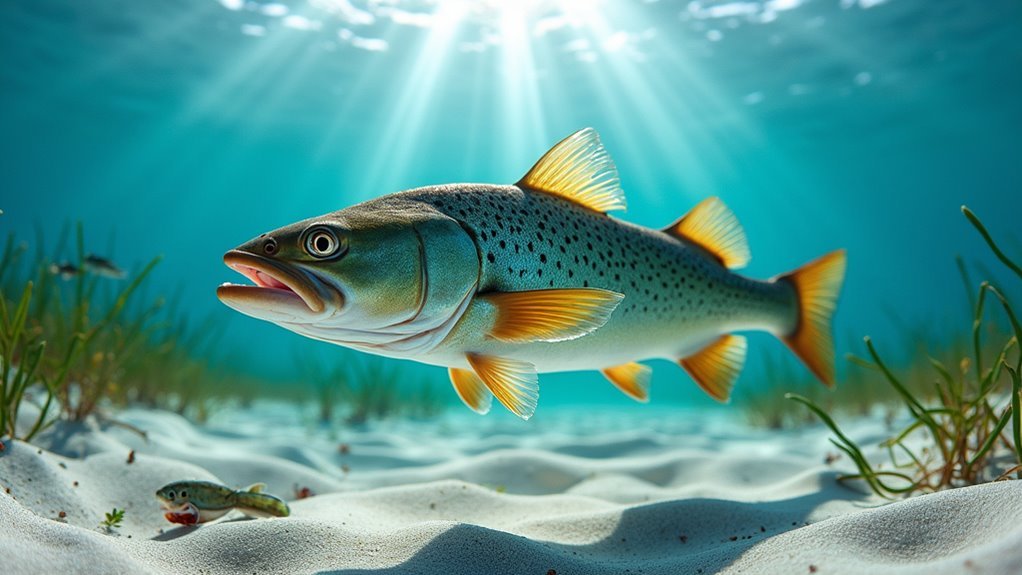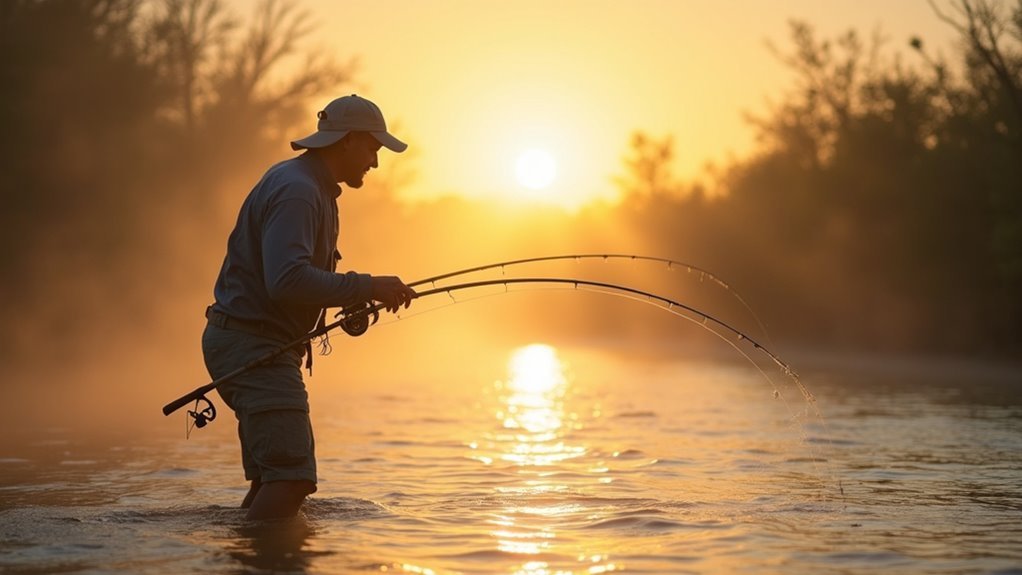Mastering speckled trout fishing relies on understanding their seasonal habits. These fish move from shallow bays in warm months to deeper waters during fall and winter migrations. Success requires appropriate gear – fast action rods paired with properly sized hooks – and effective baits like soft plastics mimicking natural prey. Techniques should match conditions: popping corks for mid-water zones, Carolina rigs in strong currents. Perhaps the most essential skill is recognizing key indicators like water color changes and baitfish activity. The difference between consistency and luck lies in these fundamental patterns.
Identifying and Understanding Speckled Trout Behavior

While many anglers focus solely on catching speckled trout, understanding the behavior of these elusive fish greatly increases success on the water.
These predatory saltwater species, with their distinctive spots and canine teeth, tend to follow predictable patterns based on seasons and conditions.
Speckled trout follow nature’s rhythms, their seasonal movements and habits revealing themselves to the observant angler.
In warmer months, they’re usually found in shallow bays near structure like seagrass and oyster beds.
Come fall and winter, they migrate to deeper waters, perhaps seeking more stable temperatures.
Their feeding habits change too—primarily pursuing shrimp and small baitfish like mullet and minnows.
I think recognizing these behavioral shifts is the difference between occasional luck and consistent catches.
Essential Gear and Tackle Selection for Trout Success
Since success in speckled trout fishing often hinges on having the right equipment, selecting appropriate gear becomes a critical first step for anglers.
Fast action, medium power rods between 62-76 inches offer versatility for various techniques. Perhaps most importantly, hook selection should match your bait—1/0 circle hooks work well for minnows and shrimp, while sizes 3-4 treble hooks suit Carolina rigs.
For tackle, I think having a mix of soft plastics that mimic natural prey is essential.
Weighted lures for deeper water and topwater torpedoes for shoreline fishing round out a well-prepared tackle box.
The right combination ultimately depends on where you’re fishing that day.
Top Baits and Lures That Trigger Aggressive Strikes
The right bait or lure can make all the difference between a successful trip and coming home empty-handed when targeting speckled trout.
Soft plastic lures, particularly those mimicking minnows or shrimp, consistently produce results across various conditions. Perhaps the most versatile option is the 3-4 inch plastic minnow in white or chartreuse.
Live bait remains king though. Small crabs work well, but nothing beats a lively minnow hooked through its lower lip.
For those working shorelines, topwater torpedoes trigger explosive strikes, especially during early mornings.
I think combining approaches – starting with topwater then switching to plastics when action slows – yields the best results.
Proven Fishing Techniques Across Different Environments

Successful speckled trout fishing demands adaptable techniques tailored to specific environments. Perhaps the most important factor is recognizing how trout behavior shifts with habitat—what works over oyster beds might fail completely along marsh edges.
- Popping cork rigs excel in mid-water zones, creating noise that mimics feeding activity.
- Carolina rigs with fresh bait prove effective in surf conditions where current runs strong.
- For grassy flats, weedless soft plastics prevent frustrating snags while enticing strikes.
- Around deeper structures, jigging with weighted lures allows precise depth control.
I think matching your approach to water clarity is essential too. In murky conditions, noisier presentations often outperform the subtle techniques that shine in clear water.
Seasonal Strategies for Year-Round Trout Fishing
Contrary to popular belief, speckled trout fishing isn’t solely a summer pursuit—each season offers unique opportunities for anglers willing to adapt their approach.
Fall fishing thrives as shrimp migrate into open waters, creating feeding frenzies near shorelines and structures.
Winter requires patience and deeper water tactics, with trout congregating over oyster reefs where water temperatures remain more stable.
Early spring can be challenging with scattered patterns, but warming trends concentrate fish near shallow grass beds.
Summer success comes with strategic timing—early mornings or late evenings when temperatures are cooler and fish are most active.
Perhaps the most important factor is recognizing how trout shift locations seasonally rather than disappearing altogether.
Finding Prime Trout Hotspots: Reading the Water
While many anglers spend hours searching for speckled trout without success, skilled fishermen know that reading water conditions greatly increases their chances of a productive day.
Understanding the subtle signs of promising trout habitat can mean the difference between a frustrating outing and a memorable catch.
- Look for water color changes – greener water often indicates higher salinity levels that trout prefer.
- Focus on structure – oyster reefs, grass beds, and marsh edges provide both cover and feeding opportunities.
- Watch for baitfish activity – small splashes or birds diving may signal trout feeding below.
- Pay attention to water movement – trout often position themselves in areas with moderate current.
Frequently Asked Questions
How Do You Properly Handle and Release Speckled Trout?
Anglers should handle speckled trout with wet hands, avoid touching gills, support the body horizontally, minimize air exposure, and release quickly by gently lowering them headfirst into water.
What Are the Best Moon Phases for Targeting Trophy Speckled Trout?
Full moon and new moon phases provide stronger tidal movements that activate trophy speckled trout feeding. The three days before and after these phases offer ideal fishing opportunities.
How Do Water Temperature Changes Affect Speckled Trout Metabolism?
How greatly do temperature shifts influence these fascinating fish? Speckled trout’s metabolism slows in colder waters, reducing feeding activity, while warmer temperatures accelerate their metabolism, increasing their appetite and movement patterns.
What’s the Ideal Leader Length and Material for Speckled Trout?
Ideal leaders for speckled trout are 12-18 inches of fluorocarbon in 15-20 pound test. This material provides low visibility while maintaining sufficient strength to handle the trout’s sharp teeth.
How Do You Clean and Prepare Speckled Trout for Cooking?
Want to properly clean speckled trout? One should scale the fish, slit the belly, remove entrails, rinse thoroughly, then fillet by cutting along the backbone and removing bones as needed.